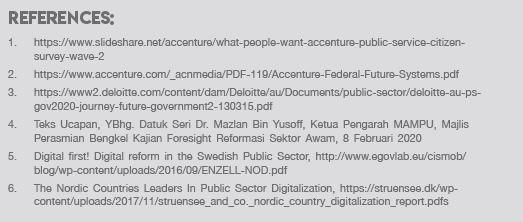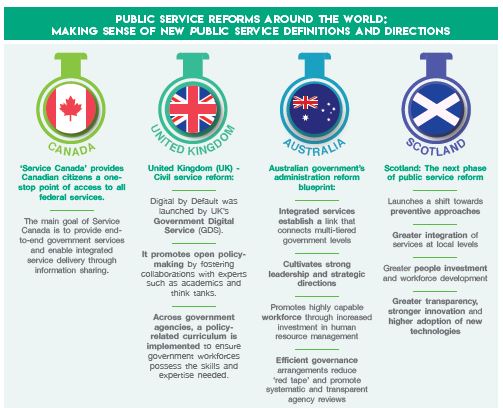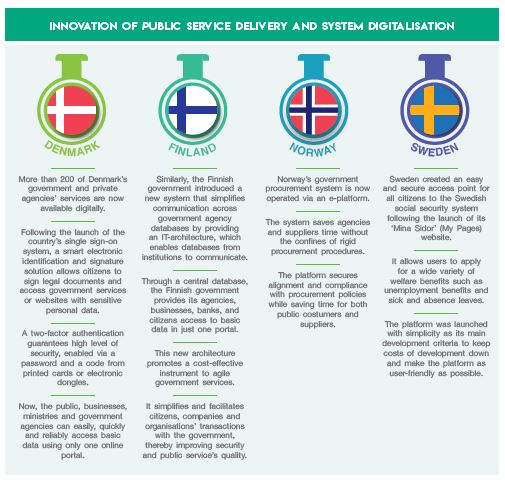by | AHMAD RAZIF MOHAMAD, razif@might.org.my | NATRAH MOHD EMRAN, natrah@might.org.my | NUR LIYANA MAISARAH MOHAMED FATHIL
Pledging reform commitment
Reforms have always mattered in public service. In fact, some of the biggest shifts in public service have occurred coming out of a crisis. Oftentimes, reforms are fundamental shake-ups carried out to super-charge public service efficiency, capability and delivery to adapt to the contours of reality-based situations and changes. The context in which public service reforms operate can thus be defined as deliberating change to the structures and processes of public sector’s agencies and services. For better or worse, public sector
reforms have touched numerous pivotal areas, remaking government structures, sector and service regulations, productivity and front-line service delivery, to name a few.
To design a successful transformation journey, governments and public sector leaders play a key role in sparking fresh reform ideas. However, a number of elements need to come together to tailor a transformation journey that promotes a resilient public sector against fast changing circumstances. Yet, to step away from today’s crisis into a much changed world, governments need to align the micro-battles facing their public sector with the demand and purpose of a new environment, rather than simply fix what is broken.
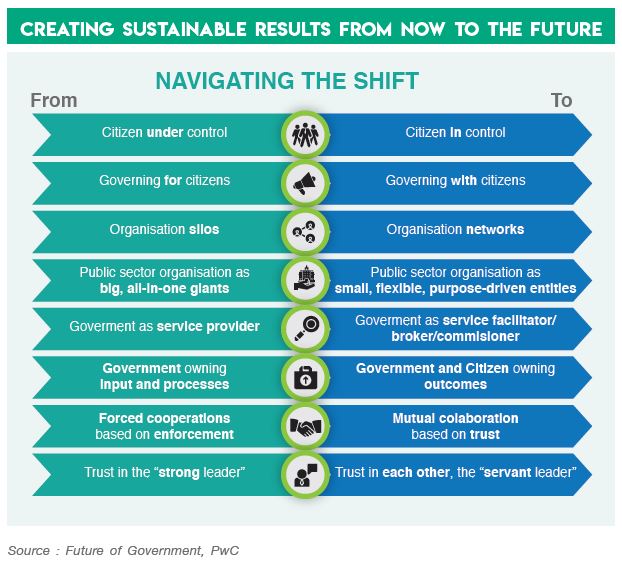
Technology convergence in today’s public service is expected to strengthen the future in three aspects:
1. Systemic changes: changes across many sectors and aspects of human life
2. Societal transformation: Impact on human identities, communities, and economic and political structures
3. New mental model: Help business, government and society navigate the radical shifts that will occur as these technologies become embedded in our lives
Deloitte’s study suggests that rapid technology advancements are triggering a far-reaching and transformative impact across geographies and industries. Technologies represent opportunities and threats, but their wide-ranging impact is indisputable.
For instance, Industry 4.0 brings the integration of cyber and physical systems. Integrated communication technologies and other networking solutions are helping government departments and agencies stay connected while relying less on physical infrastructure. Computers and networks can now monitor physical processes. A CPS component can be divided into two main functions. First, advanced connectivity ensures that real-time data acquisition can be derived from the physical world and cater information feedback from cyber space. Second, intelligent data management, analytics and computational capabilities are the enabling construct of the cyber space.
Another example is the unmanned aerial vehicles or drones contribute to domestic policing, geographical surveys, maritime patrols and delivery of goods, among multiple other commercial and military applications. The future also promises radical improvements in augmented reality with the introduction of gestural interfaces and sensory feedback that fuse the physical world with digital information.
As the size and cost of sensors and communication technologies continue to decline, the “Internet of Things” (IoT) is growing by leaps and bounds.
This article shares fitting examples of technology implementations in public service—how the convergence of technology might improve and assist the workforce, workplace, and delivery. Boundaries are increasingly blurred between humans and machines as well as IT infrastructure and applications. In such environments, shared insights are encouraged, using converged data sources, employing platforms and teams to connect with ecosystem partners, and fuelling innovation through crowdsourcing.
Public service reforms, why?
Many countries are facing mounting pressures to overcome the mismatch between public resources and increasing public demand for better services. Expectations of public reforms typically mean facilitating better service delivery and generating higher ‘value for money’. Mckinsey highlights that pressures on governments have multiplied many-fold as a result of a potent cocktail of interlocking emergencies—financial and economic crises, global pandemic issues, major shifts in energy prices, climate change, food supplies, and natural resources.
Reforms are now a necessity, no longer a choice for most. As governments assume a broader, more significant role in response to the crisis, it becomes ever more important that they should be efficient and effective—otherwise, they would compound the severity of the problems.
Reform agendas differ from country to country, but they share a few things in common. First, most governments will need to broaden their approach to reform to a dispersed, sporadic one; a single department or agency at a time can’t achieve the level of change now required. Only a few governments have adopted integrated reform programmes, but most will have no choice, but to follow suit.
With the advent of disruptive technologies altering many aspects of our lives, governments need to leverage emerging technology trends for the added benefits of tax payers.
Technology trends that will power and enable future public service
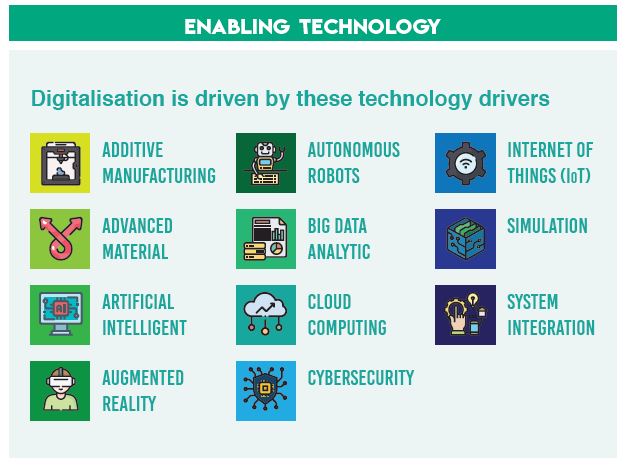
Digitisation will play a key role in impacting public sector’s transformation at large. Given its potential, digitalisation will improve productivity and promote inclusiveness of service production and public welfare delivery. In the short term, digitisation will be a precondition for establishing and maintaining sound fiscal policies. Meanwhile, in the long term, it will be equally important to maintain the public sector’s credibility in terms of how efficient and effective its delivery is and high quality services that are responsive to citizens’ needs. In turn, this nurtures public trust in governments’ capacity to boost inclusive processes and growth.
Emerging technology forces and changes
In relative terms, technological opportunities are changing the way government services interact with citizens. Data will be an integral part in the welfare sector’s policy making. Engagement too, will be a key feature of digital welfare’s development and implementation.
In addition, the importance of measurement and collection of public data are underlined as tools to create better dialogues among stakeholders—addressing asymmetrical data and information challenges.
Macro technology forces
The rise of digital experience platforms, analytics, cloud, digital reality, cognitive technologies, blockchain and IT, among others are macro forces that will combine to become formidable trends.
What can the public service do?
To attract and retain top talents, governments must explore creative new ways to converge new technologies to stimulate a modern working environment.
Ethical technology and trust
Governments need to re-evaluate how they manage data to cultivate trust and establish data leadership in regards to their products and services. This includes building a partner ecosystem and training employees, among others.
What can the public service do?
Governments are custodians of personal data. Therefore, governments need to train public service agencies and employees the proper use of data to accelerate security compliance for regulated industries and promote trustworthiness.
The future of IT in finance
Now, governments need to retool their technology strategy and action to adapt to technology innovations, agile methodologies and creative capital.
What can the public service do?
Government agencies need to remain consistent in funding the innovation of new technologies and ideas. In view of this, governments need to build more prototypes to test new ideas and make IT more efficient and effective.
Digital twins
New technologies such as 3D modelling and power visualisation are now able to create highly dynamic and detailed simulations. As these technologies scale bigger, more government agencies and businesses will be using digital twins to design new products, services, and business models to optimise processes and make data-driven decisions in real time.
What can the public service do?
Localities can take advantage of these technologies to create virtual copies of physical infrastructure such as bridges, buildings and air spaces to gain advantage in forward planning and resource optimisation.
Architecture awakens
Governments will need to evolve the way they approach architecture. Changes brought on by the digital economy require more architects to be involved in software development teams to remake IT functions into a competitive edge in the digital economy.
What can the public service do?
Governments need to attract more architects and thrust them into designing operational solutions of government services and functions. Hence, this can further accelerate technology modernisation and revitalisation.
Human experience platforms
AI-powered solutions are revitalising the way we experience technology. By combining AI, human-centred design techniques, neurological research and human experience platforms, governments will be able to humanise digital services.
What can the public service do?
Digital is the lifeblood of future government services. So much so, emotionally sensitive and context-aware interfaces will change the facade of government services.
The next horizon: A look at future trends
Governments need a new approach to sensing, scanning, vetting, experimenting, and incubating future macro technology forces to navigate future unknowns.
What can the public service do?
Future-proofing government action is an important measure to keep up with today’s fast pace of change. Sponsoring the development of nascent technologies that will radically shape the future through instruments such as research grants will help to push more innovations out faster.
Measuring and improving public service’s technology implementation returns
Some countries are head and shoulders above others in carrying out and measuring public service reforms. From our observation, two key components stand out in reforming the public sector:
1. Institutional reform and governance:
Granted, the supply and demand sides of government services are quite complex. Reforming the supply side involves overhauling state structures and strengthening public sector management. Conversely, the demand side deals with service recipients and empowering communities to tailor better service delivery.
2. Innovation of public service delivery and system digitalisation:
Safety and security are key considerations when it comes to technology adoption. Platforms and regulations work hand in hand to facilitate transactions between public agencies, citizens and businesses. Thus, managing data security while ensuring seamless service delivery has posed a tough challenge for the public service. Going forward, the challenge can only be overcome through strict regulations and SOPs.
Countries such as Denmark, Finland, Norway and Sweden have adopted robust reform approaches by applying digital technologies as a key part of their governments’ modernisation and innovation strategies.
Conclusion
At the moment, governments and businesses struggle to integrate evolving technologies and use analytics to winnow insights from data’s treasure trove. Inevitably, the post COVID-19 world will accelerate some existing
trends and create new ones. With each difficult new week of the pandemic, governments and businesses face an urgent need to improve delivery models in core sectors such as health care, transportation, security, infrastructure and management. To press forward however, IoT’s exponential growth could prove to be a regulatory headache despite the technology platform’s obvious advantage. Hence, investing significantly to capture the full value of technology-driven growth is indeed a vital decision to avoid under-deploying critical technologies in pockets with limited tools for scaling and delivering sustained impact afterwards.
Decidedly, technology should be an enabler, not the driver of public sector reforms. It makes government services more efficient and effective to serve customer needs—the Rakyat. When thinking about public sector reforms, we should also discuss making smarter use of people in generating new ideas. In many cases, the people with the best understanding of the problems and likely solutions are those working within the public sector itself.
A recent survey by Accenture suggests that modernising reform impact requires actions to be led collaboratively by public service leaders. Urgent as they are, all these questions require leaders to adopt new technologies well ahead (and in a more deliberate fashion) and reinvest more frequently. Public service leaders need to lay a strong focus on exploiting new technologies with strategies that cut across a diverse network of agencies. Using lessons from other countries’ reform narratives and micro-battles’ successes and failures, public service leaders have to be ready to exploit and pair up new technologies with the people and processes already in place.
